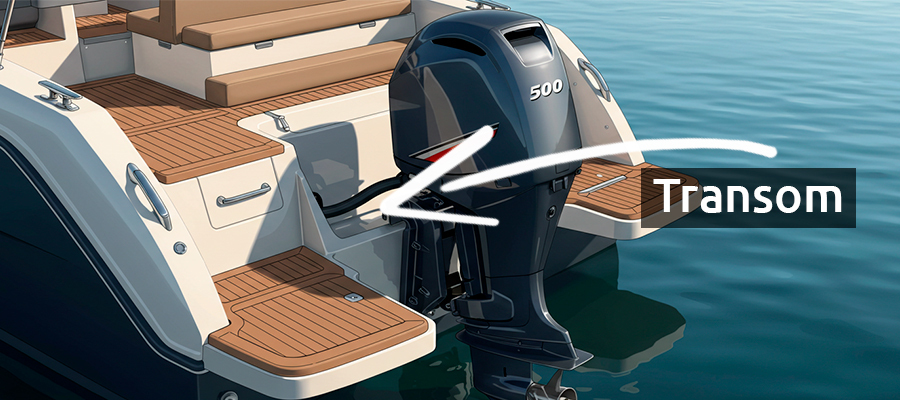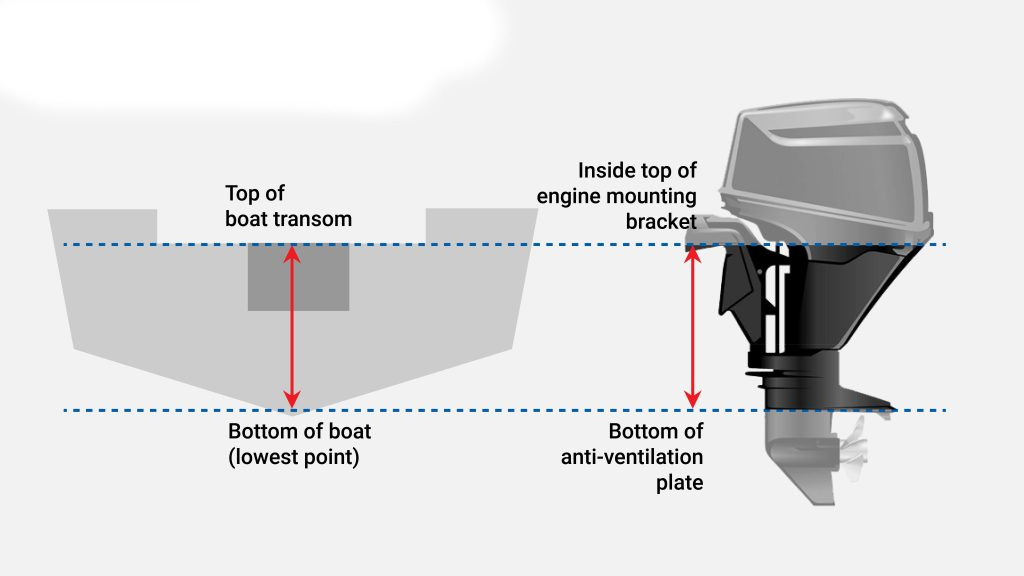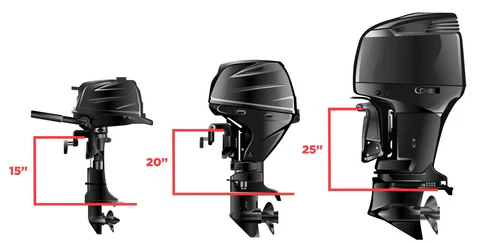Guide to Boat Transom Heights & Outboard Shaft Lengths
If you are considering a new boat that is not packaged with an outboard already mounted, you will need to learn and understand boat transom heights and how to choose the correct length outboard engine. Understanding how to select—and measure—to choose the correct shaft length will save you time, money, and lots of frustration!

Why Your Boat Transom Needs to be the Right Height?
A boat’s transom height is like the foundation of a house—it must be right, or everything else goes wrong. Here's why getting this dimension right is crucial:
1. Performance and Speed
If your outboard’s propeller isn’t sitting at the ideal depth in the water, performance suffers. Too deep and you add unnecessary drag. Too shallow and the propeller could ventilate (suck air instead of water), leading to poor acceleration and lower top-end speed.
2. Fuel Efficiency
A misaligned motor forces your engine to work harder than it should. That means more gas burned, less range, and higher operating costs—something every boater wants to avoid.
3. Handling and Stability
An improperly mounted motor can throw off your boat’s balance. You may experience issues like:
- Porpoising (the bow bouncing up and down)
- Difficulty turning at higher speeds
- Increased cavitation or ventilation
- A stern that rides too low or high in the water
4. Engine Safety
Mounting an outboard too low may allow water to enter the exhaust or engine cowling, potentially causing serious mechanical issues. Too high, and the water intake might not stay submerged, leading to overheating.
5. Boat Design Compatibility
Manufacturers design hulls with a specific transom height in mind. Deviating from that spec puts strain on the structure and undermines the intended hull performance.
Outboard Shaft Lengths - 15', 20', 25', & 30'
Outboard engines don’t come in a one-size-fits-all model. Instead, they're manufactured in a range of shaft lengths to accommodate the variety of transom heights across different boats. Getting the right match is crucial, too short and your propeller may cavitate; too long and your boat may suffer from unnecessary drag and loss of speed.
Each shaft length is designed to position the anti-ventilation plate (the horizontal fin above the propeller) flush with the bottom of the boat hull, which is key to optimal performance. Let’s break down the standard options and when you should use each.
1. Short Shaft (15 inches)
- Ideal for: Small boats like inflatable dinghies, jon boats, narrow aluminum fishing boats, and lightweight skiffs.
- Transom height compatibility: Approximately 15 inches
- Common in: Low-horsepower engines (usually under 25 HP), often tiller-controlled and portable.
Short shaft outboards are perfect for shallow, calm waters—think backwater fishing or inland lakes. These engines are easier to carry, mount, and transport, which makes them a favorite among casual anglers or boaters who use car-top or cartop boats. However, using a short shaft on a transom that’s too high will result in the propeller being too close to the surface, causing ventilation (when air gets sucked into the prop) and performance issues.
Best Use Case: Lightweight boats operating close to shorelines, calm lakes, and shallow rivers.
2. Long Shaft (20 inches)
- Ideal for: Medium-sized boats such as V-hull aluminum boats, pontoon boats, center console boats, and small fiberglass runabouts.
- Transom height compatibility: Around 20 inches
- Most common shaft length for general recreational and family boating.
The long shaft outboard is the most versatile and widely used shaft size. It accommodates a broad range of boats and water conditions. Most modern boats are designed around a 20" transom, which makes this shaft length the default for many new engine setups.
If you're planning to hit the lake with friends, go tubing, or fish from a well-sized fishing boat, chances are you’ll be using a long shaft outboard.
Best Use Case: Recreational boaters, anglers, and families using standard-size boats on lakes, rivers, and coastal bays.
3. Extra-Long Shaft (25 inches)
- Ideal for: Larger boats like sailboats, deep-V hull offshore fishing boats, or commercial vessels that operate in choppy, rough water conditions.
- Transom height compatibility: Around 25 inches
- Purpose-built to maintain propeller submersion during wave action or in high-sitting vessels.
Extra-long shafts are essential when your transom sits higher than average or if you're regularly boating in conditions where the boat will rise and fall over large swells. A regular 20" shaft may lift out of the water as the boat bounces over waves, causing cavitation and making steering unpredictable.
These motors are heavier, more powerful, and typically have electric start, hydraulic trim, and remote steering. They’re also commonly seen on sailboats because the transom sits well above the waterline, especially when the hull is loaded with gear and provisions.
Best Use Case: Offshore and coastal waters where wave height could affect engine submersion; tall-transom boats like sailboats.
4. Ultra-Long / XX-Long Shaft (30 inches or more)
- Rare and Specific To: Heavy-duty commercial boats, deep-V hull catamarans, rescue or military boats, government patrol vessels, and multi-engine offshore boats.
- Transom height compatibility: 30 inches or higher
The 30"+ shaft length is not commonly used in recreational boating. It exists to accommodate boats with very high transoms, or multi-engine applications where engines are spaced and raised to suit particular mounting brackets or hull designs.
Some offshore boats use a twin-engine or triple-engine setup, with the engines staggered in height. The outer engines may need a longer shaft to keep the prop submerged due to hull curvature or trim angles.
These are typically high-horsepower outboards (150 HP and above) and are built to withstand serious open-water use. Because of the size and torque, they require reinforced transoms and specialized rigging.
Best Use Case: Professional or heavy-duty applications; commercial-grade boating, sea rescue vessels, or long-range offshore fishing boats.
Matching Transom Height to Shaft Length

This is where the magic happens, and where many boaters go wrong. If you don’t match your boat’s transom height with the appropriate outboard shaft, your setup won't work as intended.
Basic Rule of Thumb:
| Transom Height | Recommended Shaft Length |
| 15" | Short Shaft (15") |
| 20" | Long Shaft (20") |
| 25" | Extra-Long Shaft (25") |
| 30" | Ultra-Long Shaft (30") |

But real life isn’t always that clean. Let's go deeper.
What Happens When You Mismatch?
- Too short a shaft: The prop may sit too high, causing ventilation (air intake), cavitation (bubbles that reduce thrust), poor handling, and loss of speed.
- Too long a shaft: The lower unit sits too deep, causing unnecessary drag, reduced top speed, possible stern squatting, and an increased risk of hitting submerged objects.
Special Considerations
- Boats with pods or jack plates: These modify the effective transom height and need to be accounted for.
- Boat loading and weight distribution: A heavily loaded boat sits lower in the water, affecting how deep your prop runs.
- Water conditions: Offshore and rough-water boats often benefit from longer shafts to keep the prop submerged when bouncing over waves.
How to Measure Transom Height Accurately?
You can’t pair your motor with your transom unless you know exactly what height you’re working with. Here’s how to do it, Fisrt talk about what you'll need
- Tape measure or yardstick
- A level (optional but useful for accuracy)
- A flat surface or trailer for the boat
Step To Measure Transom Height
- Place the Boat on a Level Surface: Either use a trailer or ensure the boat is resting on even ground. This avoids skewing your measurement.
- Identify the Transom Center: Find the midpoint of the transom (not the corners, which might be higher or lower depending on design).
- Measure from the Top of the Transom to the Bottom of the Hull: Start your tape at the top edge where the outboard mounts. Measure straight down to the bottom of the keel (not just the inside of the hull). If the hull curves, make sure your tape remains perpendicular to the waterline—not the angle of the transom.
- Note the Measurement: Round up or down to the nearest standard shaft length (15", 20", 25", 30"). If your measurement is in between sizes, you may need to consider a jack plate, bracket, or custom motor mount.
Example: If your measurement is 17”, a 15” shaft may sit too high, while a 20” might be just right—especially if you’re carrying gear or passengers that weigh the boat down.
FAQs
Can I use a longer shaft than my boat’s recommended height?
Yes, you won’t damage the boat, but expect more drag, reduced top speed, and caution in shallow water since the prop sits deeper.
Which boats typically need a short‑shaft outboard?
Boats with a 15–17″ transom, such as small Jon boats, zodiacs, inflatables, canoes, and sailboats with movable brackets.
Which vessels call for a long‑shaft engine?
Pontoon boats, Carolina skiffs, and other medium‑sized craft with 18–21″ aft transoms.
The Bottom Line
The right outboard shaft length isn't just about matching numbers—it's about understanding how your boat sits in the water, how it performs, and how conditions affect your ride. A properly matched shaft and transom will give you:
- Better speed and fuel economy
- Cleaner hole shots (faster planing)
- Easier steering and control
- Less strain on your motor and hull
- And ultimately, a safer boating experience
It may seem like a small detail, but it makes a big difference out on the water.
Posted by Art Vandelay


